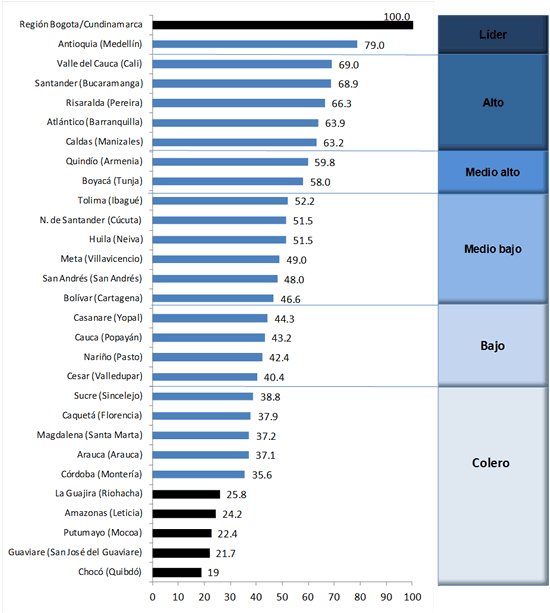ECLAC Fosters Territorial Development in Colombia with Competitiveness Indicator
Work area(s)
The Colombia Office of the Commission prepared a ranking to guide public policymaking and stimulate private decisions that can combine to yield higher levels of territorial development.

To guide public policymaking and stimulate private decisions that can combine to yield higher levels of territorial development, the Colombia Office of the Economic Commission for Latin America and the Caribbean (ECLAC) periodically presents the Competitiveness ranking for national departments.
According to the authors of the report, this indicator of economic, social and institutional development shows how departments use their various structural assets according to specific patterns of specialization.
The following six factors are analysed in the recently launched Competitiveness ranking for the departments of Colombia 2012-2013: strength of the economy; human capital; infrastructure; science and technology; public finances and management; and security.
The study shows that, for the past decade, Bogotá and Antioquia have been the leaders, followed by Valle del Cauca and Santander. Risaralda, Atlántico and Caldas also rank highly.
Quindío has been unable to move upwards and with Boyacá makes up the medium-high group. Tolima, North Santander, Meta and San Andrés shift between the medium-high and medium-low levels. Huila and Bolívar remain in the medium-low level.
The low-competitiveness group -with relative progresses- includes Casanare, Nariño, Cesar and Cauca. Lastly, Sucre, Caquetá, Magdalena, Arauca and Córdoba are losing relative competitiveness. There are also Amazonas, La Guajira, Putumayo, Guaviare and Chocó at the bottom of the table.
The ranking in this report permits guide policies for integral and more equitable development within and between territories, while also showing the importance of specific differentiated local policies based on a clearly stated set of priorities.
According to ECLAC "a multidimensional view of competitiveness allows us to appraise the distances between departments and their structural weaknesses and strengths that boost or hamper capacity building, while also providing a geographical perspective on the development of the nation as a whole".
Lastly, the document presents departmental profiles and proposes key items for the agenda of each one.
Overall ranking of competitiveness

Key:
Competitiveness ranking (in descending order): Leaders, High, Medium-high, Medium-low, Low, Lowest.
Source: Competitiveness ranking for the departments of Colombia 2012-2013.